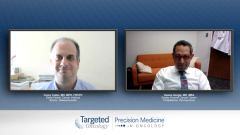
JAK Inhibitor Efficacy in Steroid Refractory GVHD
Expert physicians discuss the role and efficacy of JAK inhibitors in steroid-refractory graft-vs-host disease (GVHD).
Episodes in this series

Corey Cutler, MD, MPH, FRCPC: Why don’t you walk us through some basic information that has been shown in our research to demonstrate that JAK inhibitors are effective in graft-vs-host disease [GVHD]?
Usama Gergis, MD, MBA: Sure. The pivotal news of JAK, particularly JAK2 inhibitor ruxolitinib, is in steroid-refractory acute graft-vs-host disease. This was studied many years back. Based on efficacy in 41 patients with steroid-refractory acute GVHD, ruxolitinib was approved for that indication.
For the first time, there were pretty impressive responses. There was an overall response rate of approximately 60% at a month. Half of those were complete responses. Before that, you can get an overall response rate in this category of steroid-refractory acute GVHD using anything. It’s like trying to pick good stocks in the stock market. Whether you have experts from Wall Street or monkeys, they can perform exactly the same.
The overall response rate using CellCept, sirolimus, cyclophosphamide, ATG [anti-thymocyte globulin]—with anything—was about 30%. That was the first signal.
Corey Cutler, MD, MPH, FRCPC: Before we move on to the more recent updates, let’s take a step back. You mentioned that this is therapy in steroid-refractory acute GVHD only. We should probably define that. What are the commonly used definitions for steroid refractoriness?
Usama Gergis, MD, MBA: That’s a great question. How do we define steroid-refractory in acute graft-vs-host disease? Your patient comes in with acute GVHD on Friday. You start your first treatment: high-dose steroids.
Corey Cutler, MD, MPH, FRCPC: Is that the therapy you always start?
Usama Gergis, MD, MBA: We always start steroids, then we have to define what high dose is. For grade 1 or 2, you can start low and go up if there’s no response, or you can start everybody at 2 mg/kg prednisone equivalent and go down when there is a response.
Going back to refractoriness, if the acute GVHD grade is going up within 3 days, that’s the early sign of being steroid-refractory. If there’s no resolution within 4 weeks, that’s steroid refractoriness. Then you have mixed responses. Your patient started with stage III scan, stage II GI [gastrointestinal], and after a week they go to stage IV GI and stage I scan. There is a progression. That’s still refractory. Steroid refractoriness can be progression within 3 days, no resolution for 4 weeks.
Corey Cutler, MD, MPH, FRCPC: To be very formal about it, progression after 3 days at 2 mg/kg, lack of response after 5 to 7 days at 2 mg/kg, or lack of a complete response by day 28 would define steroid refractoriness. Steroid dependence is the inability to get down below certain doses of steroids because patients relapse with their acute GVHD, and then there is a whole other issue of steroid-intolerant patients who are very different because these are patients who respond to steroids but who cannot tolerate the toxicity of steroids themselves. Those patients need to be considered somewhat different even though they were included in some of the original ruxolitinib trials.
Transcript edited for clarity.











































